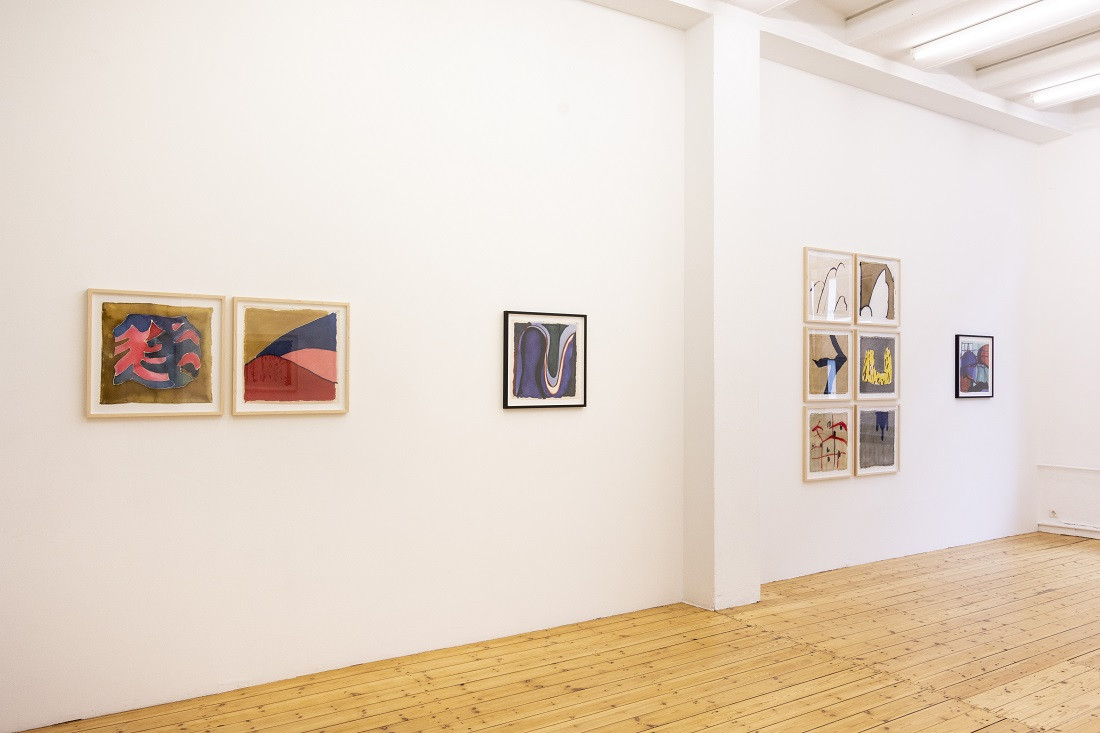From the exhibition: I Asked Myself
Nino Kvrivishvili
silk, pigment
2021
Gallery Melike Bilir
Discrete Patterns of History
by Belinda Grace Gardner
Nino Kvrivishvili — I Asked Myself
10. September — 17. October 2021
Galerie Melike Bilir
Admiralitätstr. 71
20459 Hamburg
Germany
Draped fabrics cover the walls like tight rows of curtains, their patterns closely paced. Arches, stars, circles, paisley ornaments, linear floral silhouettes, and geometrical shapes coalesce into a heterogeneous stylistic rapport. Two photos in black and white from 1969 and 1974. The earlier image depicts a showroom belonging to the textile industry that once flourished in Georgia’s capital Tbilisi: in the background, a mannequin with splayed hands in a pale, elegant sheath dress; at the table, a woman examining a piece of patterned material. The slightly later photo pictures a textile shop in Tbilisi where two women are being shown a length of dotted fabric by the saleswoman. An eternally smiling mannequin in a tailored garment visually completes the group. The images bear testimony to the golden age of the textile industry in the second half of the 20th century, which came to an end in the 1990s after the fall of the Iron Curtain.
The post-socialist decline of textile centers in Georgia, accelerated by the global exploitation economy, equally affected production and distribution facilities, the silk manufacturing company established in 1928 and the shops for precious fabrics in Tbilisi, as well as the cotton weaving mills in the city of Gori, and facilities in other places. In the 1950s, many women came to Georgia from Russia and further neighboring countries to work in the textile industry. Among these was the grandmother of the Georgian artist Nino Kvrivishvili, who was born in 1984 and is based in Tbilisi. Against the background of her textile design studies at the Tbilisi State Academy of Arts, her grandmother’s story of uprootedness and new beginnings is the starting point of a cross-generational exploration of the biographical and societal dimensions of textile production in her homeland, which was historically located on the Silk Road and is now set to become a hub on China’s currently expanding trade route to Europe.
Apart from her grandmother’s accounts and a reflection of her own experiences, the artist’s multi-strand project includes research in archives and documents and at the shut-down sites of former production. She translates the gathered materials of her investigations into drawings, silk paintings, textile wall pieces, and installations
in which she incorporates objects found at flea markets as well as private possessions. Threads running through her work are the visualization of hidden narratives inherent in the social fabric of Georgia, and specifically of the women living there, the recording of individual and collective memory, and the revitalization of spaces, times, and phenomena that have meanwhile disappeared.
In her works, Kvrivishvili reduces concrete procedures of textile manufacturing, design concepts, weaving techniques and devices, sketches from her study notes, and other elements to fragmentary details and non-representational symbols, lines, curves, dots, and interlacing meshes. Like signs of a secret code, these form mind maps or landscapes: trans-temporal abstractions, which are not immediately decipherable, evoking atmospheres and images in the viewer’s mind. The artist is not seeking to nostalgically idealize a departed era, but to bring to light what lies behind official historical narratives: the discrete energies in the everyday lives of the mostly anonymous, largely female producers of her country’s collapsed textile trade.
Due to the dissolution of the relevant enterprises in the 1990s, she herself was unable to gain practical experience in the realization of her textile designs during her studies. In a broader sense, her ciphers of bygone, increasingly forgotten realities, tools, and sites of textile production also refer to the breakdown of the economic parameters in the post-Soviet societies of Eastern and Central Europe in general: a crisis that impacted large manufacturing complexes, suppliers, and retailers in equal measure, and resulted in massive unemployment and existential strife. When Nino Kvrivishvili focuses upon the specific conditions of production, the technical means, infrastructures, spaces, aesthetic and material aspects of the textile industry, she is simultaneously engaged with revealing the subtler textures of life, the hidden, subliminal patterns of personal events from which the wider cycles of history arise.
melikebilir.com
Text Belinda Grace Gardner
Typesetting studio other types, Hamburg
© 2021 Nino Kvrivishvili, die Autorin
& Galerie Melike Bilir

